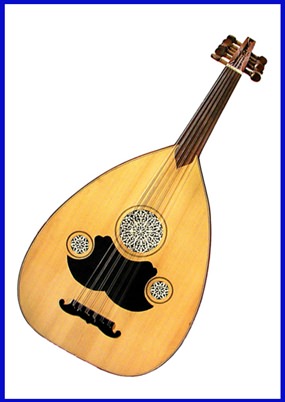A recent concert given by the Thailand Philharmonic Orchestra included an unusual work for alpenhorn – an unwieldy thing about eight feet long that has the unusual distinction of being considered a brass instrument when it’s actually made of wood.
It shares a similar honour with the saxophone, which is one of the few woodwind instruments made of brass. However, the alpenhorn has none of the usual mechanisms you find on most modern wind instruments. It has, in fact no mechanisms at all. The notes are produced by variations in the player’s embouchure, utilizing the upper partials of the harmonic series. Oh dear, that sounds a bit technical. Basically, it’s just the way you hold your mouth.
 The oud: a long history but a short neck.
The oud: a long history but a short neck.
Leopold Mozart wrote a concerto for alpenhorn, as well as concertos for other unlikely candidates like the bagpipes and the hurdy-gurdy. Then there was the Swiss composer Jean Daetwyler who also wrote a somewhat rambling concerto for alpenhorn. All of which brings me to the question, what do the these six instruments have in common? They are the pipa, the sarod, the oud, the didgeridoo, the erhu and the tar. Well, apart from not being seen very often in these parts, they’ve all had concertos written for them.
The oud (usually pronounced to rhyme with “wood”) has a long and rich history. It’s a pear-shaped plucked-string instrument common all over the Middle East and North Africa. At first glance it looks like a lute, which almost certainly developed from it, except that the neck is unusually short and there are no frets.
There’s a charming legend that the oud was invented by one Adam’s grandsons and while this might be difficult to prove, the instrument has certainly been around – in one form or another – for a few thousand years.
Marcel Khalifé was born in a small coastal village north of Beirut and was introduced to music – and the oud – at an early age. He later studied the instrument at the National Academy of Music in Beirut and in 1972 he formed a vocal group in his native village in an attempt to revive interest in Arabic choral singing. The first performances were during the Lebanese civil war when the risk of bombing was at its height. Since then Khalifé has achieved world-wide fame and in 2005 was named a UNESCO Artist for Peace. He has performed in the major concert halls of the world and had recorded more than twenty albums and DVDs.
His Andalusian Suite for Oud and Orchestra dates from 2002 and is an attractive approachable work, reflecting the southern Spanish spirit through haunting Iberian melodies and rhythms. “My music is for the service of humanity” wrote the composer, “And is intended to present a serious and sincere work for those tormented in this destructive war… a sort of balm for those wounds.” And his music does indeed have an unreal, dreamy quality at times with its insistent rhythms and hypnotic repetitive phrases.
The zheng (or guzheng) is a large Chinese plucked zither with at least eighteen strings set over movable bridges. It is thought to have originated sometime during the third century BC.
The modern zheng is quite different from those of ancient times. For example, the strings once made from silk, are now made from metal or nylon and the bodywork has been considerably improved. The zheng has an amazingly wide range of expressive sounds and is often used in Chinese popular music.
The name Tan Dun may seem unfamiliar, but if you’ve ever seen the movies Crouching Tiger, Hidden Dragon or Hero, you’ve heard his music. He’s also written many works for the concert hall and already completed five operas.
Tan Dun spent his childhood days in the village of Changsha in the Hunan province of China where he became fascinated by the rituals and ceremonies of the village shaman, usually set to music produced with natural objects such as rocks and water. He moved to New York City in the 1980s to study music at Columbia University but his fascination with natural sounds continued throughout his career and led to works like the Concerto for Water Percussion and Orchestra composed in 1998.
Tan Dun has a highly personal musical language which is derived from both classical Chinese and Western influences. It makes for fascinating listening and contains some beautiful and innovative string writing.
This compelling and surprisingly tuneful work is in four movements and employs many percussive sounds, but without the use of percussion instruments. I’ll leave you to discover for yourself how it’s done.





